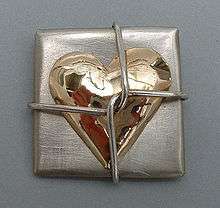Gold-filled jewelry


Gold-filled jewelry is composed of a solid layer of gold, which must constitute at least 5% of the item's total weight, mechanically bonded to sterling silver or a base metal. The related terms "rolled gold plate" and "gold overlay" may be used if the layer of gold constitutes less than 5% of the item's weight.[1][2]
Some high quality gold-filled pieces have the same appearance as 14 karat (58%) gold. Gold-filled items, even with daily wear, can last 1 to 5 years but will eventually wear through. Gold-filled items are 5 to 10 times thicker than regular gold plating, and 15 to 25 times thicker than gold electroplate (sometimes stamped HGE or HGP—usually found on cubic zirconia "cocktail rings").
Definition
In the United States, the quality of gold-filled is defined by the Federal Trade Commission (FTC). If the gold layer is 10 kt fineness, the minimum layer of karat gold in an item stamped GF must equal at least 1/10 the weight of the total item. If the gold layer is 12 kt or higher, the minimum layer of karat gold in an item stamped GF must equal at least 1/20 the weight of the total item. The most common stamps found on gold-filled jewelry are 1/20 12kt GF and 1/20 14kt GF. Also common is 1/10 10kt. Some products are made using sterling silver as the base, although this more expensive version is not common today. These standards are for modern gold-filled items. It is not uncommon to see 1/8 14kt gold-filled marks, plus many other variations, on items from the 1930s, 1940s, etc., which would have to be marked "Rolled Gold Plate".
The FTC allows the use of "rolled gold plate," "R.G.P" or "gold overlay" on items with lower thicknesses of gold than are required for "gold-filled."[2]
"Double clad" gold-filled sheet is produced with 1/2 the thickness of gold on each side. 1/20 14Kt double clad gold-filled has a layer on each side of 1/40th 14Kt making the total content of gold 1/20. The thinner layer on each side does not wear as well as single clad gold-filled.
See also
References
- ↑ "The Essential Guide to the U.S. Trade in Advertising Jewelry of Silver in Combination with Gold: Supplement" (PDF). Jewelers Vigilance Committee (JVC). Retrieved 1 April 2015.
- 1 2 "Part 23—Guides for the Jewelry, Precious Metals, and Pewter Industries". eCFR. U.S. Government Publishing Office. Retrieved 7 April 2015.